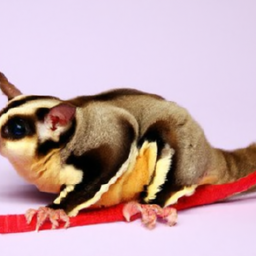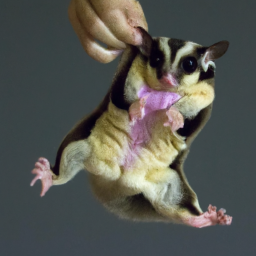Can You Put A Leash On A Sugar Glider
Hey there, have you ever wondered if you can put a leash on a sugar glider? Well, you’re in luck because we’re here to answer that question for you! Sugar gliders are adorable little creatures, and it’s only natural to want to take them out for a walk like you would with a dog or a cat. But is it actually possible to leash train a sugar glider? Stick around and find out!
In this article, we’ll delve into the world of sugar gliders and their leash-walking potential. We’ll explore whether it’s safe and practical to put a leash on these tiny marsupials. You’ll learn about the unique needs and behaviors of sugar gliders, and discover if they can adapt to leash training. So, if you’re curious about how to take your sugar glider for a stroll, keep reading and we’ll provide you with all the information you need.
Is Using a Leash an Appropriate Way to Care for a Sugar Glider as a Pet?
Using a leash for a sugar glider pet suitability is a controversial topic. While some owners believe it allows for safe outdoor exploration, others argue it can lead to stress and injury for these small, delicate animals. It’s important to research and consider the best care practices for sugar gliders as pets.
Can Putting a Leash on a Sugar Glider Cause Barking Behavior?
Putting a leash on a sugar glider can lead to barking behavior for several reasons. Sugar gliders are not naturally inclined to wear leashes, which can cause stress and anxiety. This can result in the sugar glider exhibiting barking behavior as a response to the discomfort and restriction of the leash.
Can You Put A Leash On A Sugar Glider
Owning a sugar glider as a pet can be an incredibly rewarding experience. These tiny creatures are known for their playful and affectionate nature, making them beloved companions for many. However, one question that often arises among sugar glider owners is whether or not it is possible to put a leash on these unique pets. In this article, we will explore the possibility of using leashes with sugar gliders, the benefits and considerations involved, as well as alternative options to keep them safe and secure.
Understanding Sugar Gliders
Before we delve into the topic of leashes, it is essential to have a basic understanding of sugar gliders. These small marsupials are native to Australia, Indonesia, and New Guinea. Sugar gliders are known for their membranous wings that allow them to glide effortlessly through the air. They are incredibly social animals and often form strong bonds with their human caregivers.
Benefits of Using Leashes with Sugar Gliders
Using a leash with a sugar glider may offer several benefits for both the owner and the pet. Firstly, a leash can provide a sense of safety and security when taking your sugar glider outside of their cage. It allows you to have more control over their movements and prevents them from getting lost or injured.
Secondly, a leash can facilitate outdoor adventures for your sugar glider. Taking your pet outside for supervised exploration can enrich their lives and provide them with valuable mental and physical stimulation. With the aid of a leash, you can ensure that your sugar glider stays close to you while enjoying the great outdoors.
Lastly, using a leash can help in the training process. Leash training can create a stronger bond between you and your sugar glider, as well as teach them valuable commands and recall skills. It provides an additional layer of safety during this training phase.
Considerations Before Using a Leash
While the idea of putting a leash on your sugar glider may sound appealing, it is essential to consider a few factors before proceeding. Firstly, it is important to remember that sugar gliders are delicate creatures with unique needs. They have a high metabolic rate and require a specific diet, proper housing conditions, and ample social interaction. Leashing your sugar glider should only be done after careful consideration and consultation with an experienced veterinarian.
Secondly, some sugar gliders may not take well to being leashed. Just like humans, sugar gliders differ in their personalities and temperaments. Some may feel stressed or anxious when restrained by a leash, potentially leading to behavior issues or health problems. It is crucial to assess your sugar glider’s comfort level before attempting to leash train them.
Choosing the Right Leash for Sugar Gliders
If you decide to proceed with leash training, it is important to choose the right kind of leash for your sugar glider. As they are small and delicate animals, traditional dog or cat leashes are not suitable. Instead, opt for a specially designed sugar glider leash or a lightweight bird harness. These options are typically made from soft, breathable materials that won’t constrict or harm your pet.
Ensure that the leash or harness you choose is adjustable and allows for a secure yet comfortable fit. It should not rub against their skin or inhibit their ability to glide or move naturally. Always prioritize the well-being and safety of your sugar glider when selecting a leash.
Training Your Sugar Glider to Wear a Leash
Before venturing outside, it is crucial to train your sugar glider to wear a leash or harness comfortably. The training process involves gradual desensitization and positive reinforcement. Here is a step-by-step guide to leash training your sugar glider:
-
Start by introducing your sugar glider to the leash or harness indoors in a calm and familiar environment. Allow them to sniff and investigate the equipment at their own pace.
-
Once your sugar glider is comfortable with the leash’s presence, gently place it around their body. Be patient and allow them time to adjust to the sensation.
-
Offer your sugar glider treats or rewards while they are wearing the leash to establish positive associations. This step helps to reinforce the idea that wearing a leash is a positive and rewarding experience.
-
Gradually increase the amount of time your sugar glider spends wearing the leash each day. Monitor their behavior closely and check for any signs of discomfort or distress.
-
Once your sugar glider has adapted to wearing the leash indoors, you can start taking short trips outdoors, always within a safe and controlled environment. Gradually increase the duration and distance of these outings over time.
Remember to never force your sugar glider to wear a leash or harness if they show signs of stress or discomfort. The training process should always be conducted at their own pace, ensuring their welfare throughout.
Common Challenges and How to Overcome Them
Leash training a sugar glider may not be a smooth process for every owner. There are several common challenges that may arise, including:
-
Escape attempts: Sugar gliders are agile and curious creatures, and they may try to wiggle or slip out of their leash. To overcome this, ensure that the leash is properly secured and that it fits snugly but comfortably.
-
Fear or anxiety: Some sugar gliders may display signs of fear or anxiety when first introduced to a leash. To help them overcome these emotions, gradually expose them to the leash and offer reassurance through treats and affection.
-
Distractions: Sugar gliders have a natural curiosity, which means they may become easily distracted during outdoor adventures. Keep a close eye on your pet and use positive reinforcement techniques to redirect their attention and keep them focused.
-
Interaction with other animals: While outdoors, your sugar glider may encounter other animals. It is crucial to keep a safe distance from potential predators and ensure that your pet is not exposed to any harmful situations.
Ensuring Safety While Using Leashes
When using a leash with your sugar glider, it is vital to prioritize their safety at all times. Here are a few key tips to ensure their well-being:
-
Always supervise your sugar glider while they are wearing a leash, both indoors and outdoors.
-
Avoid exposing your sugar glider to extreme temperatures or inclement weather conditions. Sugar gliders are sensitive to temperature changes and should be kept in a safe and comfortable environment.
-
Beware of potential hazards such as sharp objects, entangling vegetation, or other animals that may pose a threat to your sugar glider’s safety.
-
Regularly inspect the leash for any signs of wear and tear. Replace the leash if it becomes frayed or damaged to avoid accidents or escapes.
By following these safety guidelines, you can provide your sugar glider with a secure and enjoyable leash experience.
Alternative Options to Leashing
If you find that leashing your sugar glider is not the right option for you or your pet, there are alternative ways to ensure their safety during outdoor activities. Sugar glider bonding pouches or specially designed backpacks can allow you to carry your pet close to your body while still providing them with the ability to move and explore.
It is important to note that these alternative options should be used with caution and always under close supervision. Sugar gliders are naturally curious, and it is essential to prevent any potential accidents or escapes.
Conclusion
In conclusion, while it is technically possible to put a leash on a sugar glider, it is important to approach this task with caution and consideration for the well-being of your pet. Leash training can provide numerous benefits, including safety, outdoor exploration, and improved training opportunities. However, it is crucial to assess your sugar glider’s comfort and temperament before proceeding.
Remember to choose the right leash or harness, train your sugar glider gradually and positively, and ensure their safety at all times. Leash training should always be conducted in a patient and gentle manner, prioritizing the welfare of your beloved sugar glider.


